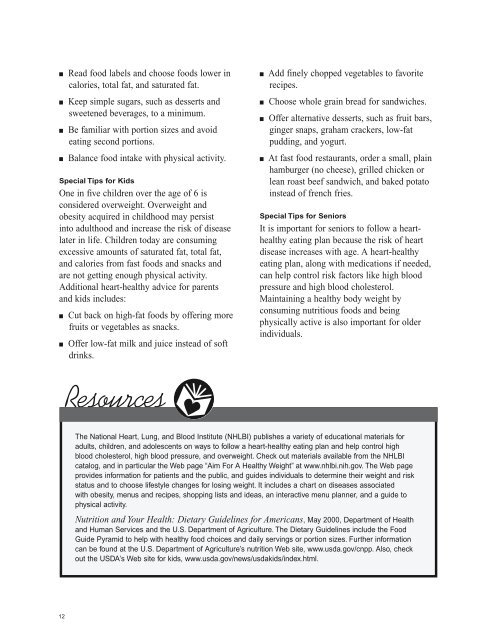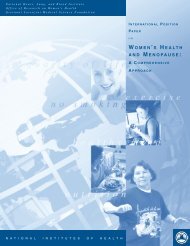HeartsNParks Community Mobilization Guide - National Heart, Lung ...
HeartsNParks Community Mobilization Guide - National Heart, Lung ...
HeartsNParks Community Mobilization Guide - National Heart, Lung ...
Create successful ePaper yourself
Turn your PDF publications into a flip-book with our unique Google optimized e-Paper software.
■ Read food labels and choose foods lower in<br />
calories, total fat, and saturated fat.<br />
■ Keep simple sugars, such as desserts and<br />
sweetened beverages, to a minimum.<br />
■ Be familiar with portion sizes and avoid<br />
eating second portions.<br />
■ Balance food intake with physical activity.<br />
Special Tips for Kids<br />
One in five children over the age of 6 is<br />
considered overweight. Overweight and<br />
obesity acquired in childhood may persist<br />
into adulthood and increase the risk of disease<br />
later in life. Children today are consuming<br />
excessive amounts of saturated fat, total fat,<br />
and calories from fast foods and snacks and<br />
are not getting enough physical activity.<br />
Additional heart-healthy advice for parents<br />
and kids includes:<br />
■ Cut back on high-fat foods by offering more<br />
fruits or vegetables as snacks.<br />
■ Offer low-fat milk and juice instead of soft<br />
drinks.<br />
12<br />
■ Add finely chopped vegetables to favorite<br />
recipes.<br />
■ Choose whole grain bread for sandwiches.<br />
■ Offer alternative desserts, such as fruit bars,<br />
ginger snaps, graham crackers, low-fat<br />
pudding, and yogurt.<br />
■ At fast food restaurants, order a small, plain<br />
hamburger (no cheese), grilled chicken or<br />
lean roast beef sandwich, and baked potato<br />
instead of french fries.<br />
Special Tips for Seniors<br />
It is important for seniors to follow a hearthealthy<br />
eating plan because the risk of heart<br />
disease increases with age. A heart-healthy<br />
eating plan, along with medications if needed,<br />
can help control risk factors like high blood<br />
pressure and high blood cholesterol.<br />
Maintaining a healthy body weight by<br />
consuming nutritious foods and being<br />
physically active is also important for older<br />
individuals.<br />
The <strong>National</strong> <strong>Heart</strong>, <strong>Lung</strong>, and Blood Institute (NHLBI) publishes a variety of educational materials for<br />
adults, children, and adolescents on ways to follow a heart-healthy eating plan and help control high<br />
blood cholesterol, high blood pressure, and overweight. Check out materials available from the NHLBI<br />
catalog, and in particular the Web page “Aim For A Healthy Weight” at www.nhlbi.nih.gov. The Web page<br />
provides information for patients and the public, and guides individuals to determine their weight and risk<br />
status and to choose lifestyle changes for losing weight. It includes a chart on diseases associated<br />
with obesity, menus and recipes, shopping lists and ideas, an interactive menu planner, and a guide to<br />
physical activity.<br />
Nutrition and Your Health: Dietary <strong>Guide</strong>lines for Americans, May 2000, Department of Health<br />
and Human Services and the U.S. Department of Agriculture. The Dietary <strong>Guide</strong>lines include the Food<br />
<strong>Guide</strong> Pyramid to help with healthy food choices and daily servings or portion sizes. Further information<br />
can be found at the U.S. Department of Agriculture’s nutrition Web site, www.usda.gov/cnpp. Also, check<br />
out the USDA’s Web site for kids, www.usda.gov/news/usdakids/index.html.
















